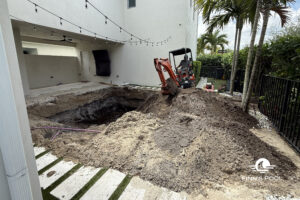In Florida, pool surfaces work harder than you think. To extend the life of your pool, you need to stay ahead of wear and tear from sun, salt, and chemical exposure. Thanks to this constant onslaught of the elements, the once-smooth finish starts to fade, roughen, or even crack. Therefore, it is essential to invest in scheduled pool resurfacing to extend the life of your pool and keep it smooth, watertight, and structurally sound.
Pool resurfacing professionals can help you stop structural problems before they start and extend the lifespan of your pool. By doing this, they protect the value of your property for years to come. Swimming pool resurfacing is what separates a durable pool that lasts for decades from one that encounters new problems every season. And in Florida’s heat and humidity, well-timed swimming pool resurfacing is non-negotiable.
Tiny cracks appear, textures roughen, and stains become harder to scrub away. Left untreated, these minor signs of wear can develop into expensive pool repairs and even compromise the pool’s structure. Don’t wait for essential maintenance. Spot early warning signs and take action to extend the life of your pool and avoid costly mistakes.
How to Spot Early Signs of Pool Surface Damage?
Most homeowners do not notice pool surface problems until they become unfixable and stand out like a thorn. However, some early signs can provide clues to these problems when they’re still manageable. The good news is that these issues are usually noticeable with a quick inspection. Here’s what to look for:
Rough or Sandpaper-Like Texture
The smooth surface of your pool should not feel abrasive. The roughness of a pool surface can be the result of old, withering plaster or calcium scale buildup. Such damage can lead to discomfort while swimming or may also cause scrapes and injuries among children.
Spot it Early: Run your hand or foot along the pool’s walls or steps. So, if the pool surface is rough to the touch, you see white spots on the floor, or if you are experiencing bruising when your skin brushes against the pool, it’s time you got pool resurfacing.
Persistent Discoloration or Spots that Don’t Scrub Off
Stains are a common complaint among swimming pool owners. While stains from organic matter or metal debris can be wiped away with a good scrub, stubborn dark blotches are indicative of surface porosity. This happens when the plaster is withering down and absorbing minerals, dirt, and algae, leaving dark spots behind that can’t be scrubbed off.
Spot it Early: Look for areas that stay dark even after brushing, or appear etched into the plaster. This is often one of the first visible signs that pool refinishing will soon be needed.
Flaking or Peeling
If your pool’s plaster is flaking off or peeling away, it indicates a weakening bond between the top coat and the base material. It can happen due to many reasons, including aging plaster, chemical imbalances, and cold-hot cycles. The humid climate of West Palm Beach can also accelerate the damage.
Spot it Early: Peeling patches near steps or shallow ends, or plaster flakes collecting in your pool vacuum signal a damaged surface in need of urgent attention.
Frequent Water Loss & Cracks
Cracks and leaks in swimming pools should always be taken seriously. Even a hairline crack in your pool’s surface can lead to major problems. Such cracks can be caused by ground movement, structural issues, or chemical corrosion, which in turn weaken the plaster shell. If you ignore these small cracks, the water will continue to seep out and damage other parts of the pool, not to mention the surrounding deck.
Spot it Early: Tiny fractures along the floor or corners, unexplained water loss (more than 0.25 inch per day), or wet spots in the lawn near your pool.
Powdery Residue or Chalking
Chalking refers to white residue or dusty film that adheres to the top of your pool walls. Its appearance indicates that the top layer of the pool is deteriorating, possibly due to age or a pH imbalance. Left unchecked, this powdery residue can cause the pool to become cloudy and difficult to clean.
Spot it Early: Cloudy water after brushing the pool or fine white residue on your pool brush or hands can offer clues to this issue.
👉 Want to learn more to extend the life of your pool? Here is our dedicated blog describing in detail the signs that you need pool resurfacing.
How Does Pool Resurfacing Work?
How This Process Helps Extend the Life of Your Pool
The price to resurface a pool typically ranges between $4,000 and $10,000, depending on the pool’s size, the nature of the damage, and the material used. While it’s an investment, pool refinishing costs significantly less than repairing structural damage or replacing the pool altogether.
Pool resurfacing isn’t as simple as applying a fresh coat of paint. It’s a careful, multi-step procedure designed to extend the life of your pool by protecting your investment from the inside out. Here’s how it’s done:
Drain the Pool Completely
Every resurfacing project begins with draining the pool. This allows contractors to inspect the structure for cracks, stains, or areas where the surface has separated from the shell.
Prep the Surface
The old plaster or finish is removed using hydroblasting or sandblasting. It ensures that the new surface bonds securely. Any structural cracks or hollow areas are repaired to restore integrity.
Apply the New Finish
Once the surface is clean and repaired, a fresh layer of pool replastering, quartz, or pebble material is applied. This is central to swimming pool resurfacing. It creates a watertight, smooth, long-lasting surface.
Cure and Refill
After application, the new finish needs several days to cure. During this period, maintaining proper pH balance and brushing the surface helps ensure a flawless result before refilling with water.
Final Chemical Balance
Once refilled, the pool’s water chemistry is stabilized to protect the new surface and extend its lifespan.
Pool resurfacing is a crucial step in pool maintenance. You should only hire professional and experienced pool repair service providers so that you get the most out of your pool resurfacing project.
👉 Read more about the hidden costs of neglecting pool maintenance in our detailed guide for first-time pool owners.
How Pool Resurfacing Helps Extend the Life of Your Pool
Without proper pool resurfacing, the elements will slowly erode the top layer of your swimming pool, leading to cracks, leaks, and structural damage that can cost thousands to repair. Pool resurfacing saves the cost of major repairs, and protects the investment you have already made in your pool. In fact, Angi highlights six key reasons why resurfacing your pool can improve safety, reduce water loss, and save money over time.
- Prevents leaks and concrete erosion: A fresh layer of pool replastering or pool refinishing seals the shell, keeping water inside the pool and protecting the underlying concrete from corrosion. Once the integrity of that layer is compromised, water can seep into the structure, eroding rebar and concrete from within. It is a slow, silent problem that often goes unnoticed until it becomes an expensive issue.
- Protects your plumbing and circulation systems: When the surface is damaged, water pressure and flow can become uneven, forcing pumps and filters to work harder. By restoring a smooth, even finish, swimming pool resurfacing reduces mechanical strain and helps equipment last longer.
- Resurfacing improves efficiency: A clean, properly sealed surface makes it harder for algae to cling, resulting in reduced chemical usage and lower energy consumption during water filtration. That’s not only good for your wallet, but also better for the environment.
- Extends the life of your pool and preserves your property value: A well-maintained pool signals a well-cared-for home. Whether you plan to stay or sell, pool recoating keeps your outdoor space looking polished and safe, while preventing the kind of structural damage that can turn a luxury feature into a liability.
Protect the Heart of Your Backyard
Your pool is the heart of your backyard, and resurfacing is how you keep it strong and healthy. A fresh finish prevents cracks, stops leaks, and protects every inch of your investment from Florida’s sun, storms, and salt air.
Every year you delay is a year of added risk. By resurfacing now, you extend the life of your pool, protect your investment, and avoid bigger repairs later. By resurfacing now, you restore beauty, extend lifespan, and ensure your pool stays safe, smooth, and swim-ready.
Don’t wait for damage to force your hand. Schedule a professional pool resurfacing and give your backyard the care it deserves. A resilient, polished pool isn’t just a luxury; it’s a peace of mind you can see and feel.
Reach out to a licensed pool professional at Finn’s Pool Service today. You can contact us at 561-702-6351 for expert and personalized advice.
- Phone: 561-702-6351
- Email: [email protected]
-
Address: 1335 Old Okeechobee Rd. #450
West Palm Beach, FL 33401 - Mon – Fri: 8:00 AM – 6:00 PM
- Sat & Sun: 9:30 AM – 4:00 PM



